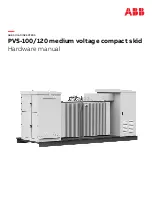
E_ HD(i)_Guide (E-HD(i)-GD-1113-EN)
9
WARNING!
This equipment contains components that may produce arcs or sparks. To reduce the
risk of fire or explosion, do not install in a compartment containing batteries or
flammable materials, or in a location that requires ignition protected equipment.
3.2
Mounting the inverter
The inverter must be mounted on a flat and even surface using the mounting flanges. Mounting hardware should
be corrosion resistant, and strong enough to support the weight of the inverter. The inverter may be mounted on
a vertical surface (the fans’ opening must not point down) or on a horizontal surface. Upside down installation
will damage your inverter.
If your inverter is equipped with a remote control, it is the right time to think about where to install it so you can
run the jack at this stage of the installation.
3.3
Battery cables
Proper wiring is very important for safe and proper operation of the inverter. Because a power inverter has a low
voltage / high current input, low resistance wiring and connections between the batteries and the inverter are
essential in order to deliver the maximum amount of usable energy to your loads.
Our CM series installation kits are made with premium quality welding cables and of the proper gauge for
maximum connectivity between the batteries and your inverter. Keep the cable length as short as possible by
selecting the kit with the required cable length. This will ensure that the overall system efficiency will be as high
as possible.
3.4
Strain reliefs installation
Close to the inverter, prepare to drill two holes (about 3 inches apart (7.6cm) in the truck’s floor to install the
two strain reliefs already installed on the DC cables. On a truck with a “sleeper”- be careful not to drill on cab
cross-members as it may weaken the cabin structure. Also, be careful not to drill into hoses (Coolant or AC).
Drill 1/8” pilot holes first to confirm you are in a convenient location to drill the larger holes. Strain reliefs vary
in size upon the inverter capacity. Make sure to use the right size hole saw.
3.5
Ground (not the negative)
The inverter housing must be connected to the chassis or to a metallic panel connected to the chassis. This
grounding procedure conforms to most electrical codes that require to derived AC sources to ground in case of
malfunctioning. Most cab structures allowing for a strong install point for an inverter are generally linked to the
chassis of the vehicle. For this reason, NO GROUNDING material is included in the CM Series installation kits.
To make sure that your inverter is grounded properly, run a 12 volt test light from the positive terminal of your
battery to your inverter mounting point; if the light comes on, your installation is OK. If not, use the lug on the
rear panel and a #8 AWG copper cable to connect the inverter to a good grounding point.
WARNING! Do not connect the ground lug to the negative input of the inverter. It will not provide the
adequate level of safety required by most electrical codes.





































